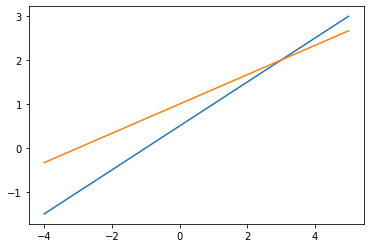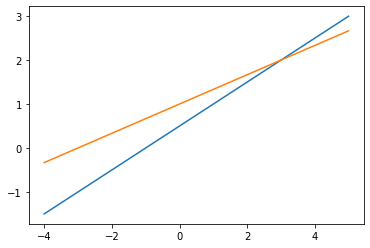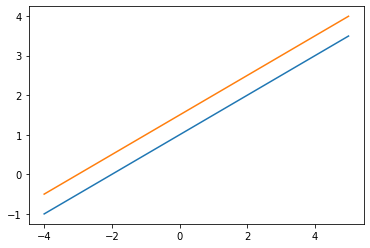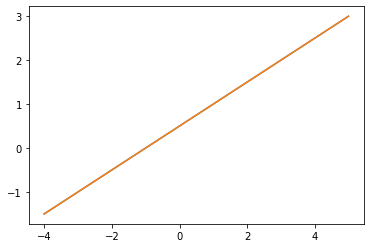利用Python学习线性代数 -- 1.1 线性方程组
利用Python学习线性代数 -- 1.1 线性方程组
本节实现的主要功能函数,在源码文件linear_system中,后续章节将作为基本功能调用。
线性方程
线性方程组由一个或多个线性方程组成,如
x_1 - 2 x_2 &= -1\\
-x_1 + 3 x_2 &= 3
\end{array}
\]
求包含两个变量两个线性方程的方程组的解,等价于求两条直线的交点。
这里可以画出书图1-1和1-2的线性方程组的图形。
通过改变线性方程的参数,观察图形,体会两个方程对应直线平行、相交、重合三种可能。
那么,怎么画二元线性方程的直线呢?
方法是这样的:
假如方程是 \(a x_1 + b x_2 = c\) 的形式,可以写成 \(x_2 = (c - a x_1) / b\)。
在以 \(x_1\) 和\(x_2\)为两个轴的直角坐标系中,\(x_1\)取一组值,如 \((-3, -2.9, -2.8, \dots, 2.9, 3.0)\),
计算相应的 \(x_2\),然后把所有点 \((x_1, x_2)\) 连起来成为一条线。
当 \(b\) 为 \(0\) 时, 则在\(x_1 = c / a\)处画一条垂直线。
# 引入Numpy和 Matplotlib库import numpy as npfrom matplotlib import pyplot as plt
Matplotlib 是Python中使用较多的可视化库,这里只用到了它的一些基本功能。
def draw_line(a, b, c, start=-4,stop=5, step=0.01):"""根据线性方程参数绘制一条直线"""# 如果b为0,则画一条垂线if np.isclose(b, 0):plt.vlines(start, stop, c / a)else: # 否则画 y = (c - a*x) / bxs = np.arange(start, stop, step)plt.plot(xs, (c - a*xs)/b)
# 1.1 图1-1draw_line(1, -2, -1)draw_line(-1, 3, 3)

def draw_lines(augmented, start=-4,stop=5, step=0.01):"""给定增广矩阵,画两条线."""plt.figure()for equation in augmented:draw_line(*equation, start, stop, step)plt.show()
# Fig. 1-1# 增广矩阵用二维数组表示# [[1, -2, -1], [-1, 3, 3]]# 这些数字对应图1-1对应方程的各项系数draw_lines([[1, -2, -1], [-1, 3, 3]])

# Fig. 1-2draw_lines([[1, -2, -2], [-1, 2, 3]])# Fig. 1-3draw_lines([[1, -2, -1], [-1, 2, 1]])


- 建议:改变这些系数,观察直线,体会两条直线相交、平行和重合的情况
例如
draw_lines([[1, -2, -2], [-1, 2, 9]])
如果对Numpy比较熟悉,则可以采用更简洁的方式实现上述绘图功能。
在计算多条直线方程时,可以利用向量编程的方式,用更少的代码实现。
def draw_lines(augmented, start=-4,stop=5, step=0.01):"""Draw lines represented by augmented matrix on 2-d plane."""am = np.asarray(augmented)xs = np.arange(start, stop, step).reshape([1, -1])# 同时计算两条直线的y值ys = (am[:, [-1]] - am[:, [1]]*xs) / am[:, [0]]for y in ys:plt.plot(xs[0], y)plt.show()
矩阵记号
矩阵是一个数表,在程序中通常用二维数组表示,例如
# 嵌套列表表示矩阵matrix = [[1, -2, 1, 0],[0, 2, -8, 8],[5, 0, -5, 10]]matrix
[[1, -2, 1, 0], [0, 2, -8, 8], [5, 0, -5, 10]]
实际工程和研究实践中,往往会采用一些专门的数值计算库,简化和加速计算。
Numpy库是Python中数值计算的常用库。
在Numpy中,多维数组类型称为ndarray,可以理解为n dimensional array。
例如
# Numpy ndarray 表示矩阵matrix = np.array([[1, -2, 1, 0],[0, 2, -8, 8],[5, 0, -5, 10]])matrix
array([[ 1, -2, 1, 0],[ 0, 2, -8, 8],[ 5, 0, -5, 10]])
解线性方程组
本节解线性方程组的方法是 高斯消元法,利用了三种基本行变换。
- 把某个方程换成它与另一个方程的倍数的和;
- 交换两个方程的位置;
- 某个方程的所有项乘以一个非零项。
假设线性方程的增广矩阵是\(A\),其第\(i\)行\(j\)列的元素是\(a_{ij}\)。
消元法的基本步骤是:
- 增广矩阵中有 \(n\) 行,该方法的每一步处理一行。
- 在第\(i\)步,该方法处理第\(i\)行
- 若\(a_{ii}\)为0,则在剩余行 \(\{j| j \in (i, n]\}\)中选择绝对值最大的行\(a_{ij}\)
- 若\(a_{ij}\)为0,返回第1步。
- 否则利用变换2,交换\(A\)的第\(i\)和\(j\)行。
- 若\(a_{ii}\)为0,则在剩余行 \(\{j| j \in (i, n]\}\)中选择绝对值最大的行\(a_{ij}\)
- 利用行变换3,第\(i\)行所有元素除以\(a_{ii}\),使第 \(i\) 个方程的第 \(i\)个 系数为1
- 利用行变换1,\(i\)之后的行减去第\(i\)行的倍数,使这些行的第 \(i\) 列为0
- 在第\(i\)步,该方法处理第\(i\)行
为了理解这些步骤的实现,这里先按书中的例1一步步计算和展示,然后再总结成完整的函数。
例1的增广矩阵是
\begin{array}
&1 & -2 & 1 & 0\\
0 & 2 & -8 & 8\\
5 & 0 & -5 & 10
\end{array}
\right]
\]
# 增广矩阵A = np.array([[1, -2, 1, 0],[0, 2, -8, 8],[5, 0, -5, 10]])# 行号从0开始,处理第0行i = 0# 利用变换3,将第i行的 a_ii 转成1。这里a_00已经是1,所不用动# 然后利用变换1,把第1行第0列,第2行第0列都减成0。# 这里仅需考虑i列之后的元素,因为i列之前的元素已经是0# 即第1行减去第0行的0倍# 而第2行减去第0行的5倍A[i+1:, i:] = A[i+1:, i:] - A[i+1:, [i]] * A[i, i:]A
array([[ 1, -2, 1, 0],[ 0, 2, -8, 8],[ 0, 10, -10, 10]])
i = 1# 利用变换3,将第i行的 a_ii 转成1。A[i] = A[i] / A[i, i]A
array([[ 1, -2, 1, 0],[ 0, 1, -4, 4],[ 0, 10, -10, 10]])
# 然后利用变换1,把第2行第i列减成0。A[i+1:, i:] = A[i+1:, i:] - A[i+1:, [i]] * A[i, i:]A
array([[ 1, -2, 1, 0],[ 0, 1, -4, 4],[ 0, 0, 30, -30]])
i = 2# 利用变换3,将第i行的 a_ii 转成1。A[i] = A[i] / A[i, i]A
array([[ 1, -2, 1, 0],[ 0, 1, -4, 4],[ 0, 0, 1, -1]])
消元法的前向过程就结束了,我们可以总结成一个函数
def eliminate_forward(augmented):"""消元法的前向过程.返回行阶梯形,以及先导元素的坐标(主元位置)"""A = np.asarray(augmented, dtype=np.float64)# row number of the last rowpivots = []i, j = 0, 0while i < A.shape[0] and j < A.shape[1]:A[i] = A[i] / A[i, j]if (i + 1) < A.shape[0]: # 除最后一行外A[i+1:, j:] = A[i+1:, j:] - A[i+1:, [j]] * A[i, j:]pivots.append((i, j))i += 1j += 1return A, pivots
这里有两个细节值得注意
- 先导元素 \(a_{ij}\),不一定是在主对角线位置,即 \(i\) 不一定等于\(j\).
- 最后一行只需要用变换3把先导元素转为1,没有剩余行需要转换
# 测试一个增广矩阵,例1A = np.array([[1, -2, 1, 0],[0, 2, -8, 8],[5, 0, -5, 10]])A, pivots = eliminate_forward(A)print(A)print(pivots)
[[ 1. -2. 1. 0.][ 0. 1. -4. 4.][ 0. 0. 1. -1.]][(0, 0), (1, 1), (2, 2)]
消元法的后向过程则更简单一些,对于每一个主元(这里就是前面的\(a_{ii}\)),将其所在的列都用变换1,使其它行对应的列为0.
for i, j in reversed(pivots):A[:i, j:] = A[:i, j:] - A[[i], j:] * A[:i, [j]]A
array([[ 1., 0., 0., 1.],[ 0., 1., 0., 0.],[ 0., 0., 1., -1.]])
def eliminate_backward(simplified, pivots):"""消元法的后向过程."""A = np.asarray(simplified)for i, j in reversed(pivots):A[:i, j:] = A[:i, j:] - A[[i], j:] * A[:i, [j]]return A
至此,结合 eliminate_forward 和eliminate_backward函数,可以解形如例1的线性方程。
然而,存在如例3的线性方程,在eliminate_forward算法进行的某一步,主元为0,需要利用变换2交换两行。
交换行时,可以选择剩余行中,选择当前主元列不为0的任意行,与当前行交换。
这里每次都采用剩余行中,当前主元列绝对值最大的行。
补上行交换的前向过程函数如下
def eliminate_forward(augmented):"""消元法的前向过程"""A = np.asarray(augmented, dtype=np.float64)# row number of the last rowpivots = []i, j = 0, 0while i < A.shape[0] and j < A.shape[1]:# if pivot is zero, exchange rowsif np.isclose(A[i, j], 0):if (i + 1) < A.shape[0]:max_k = i + 1 + np.argmax(np.abs(A[i+1:, i]))if (i + 1) >= A.shape[0] or np.isclose(A[max_k, i], 0):j += 1continueA[[i, max_k]] = A[[max_k, i]]A[i] = A[i] / A[i, j]if (i + 1) < A.shape[0]:A[i+1:, j:] = A[i+1:, j:] - A[i+1:, [j]] * A[i, j:]pivots.append((i, j))i += 1j += 1return A, pivots
行交换时,有一种特殊情况,即剩余所有行的主元列都没有非零元素。
这种情况下,在当前列的右侧寻找不为零的列,作为新的主元列。
# 用例3测试eliminate_forwardaug = [[0, 1, -4, 8],[2, -3, 2, 1],[4, -8, 12, 1]]echelon, pivots = eliminate_forward(aug)print(echelon)print(pivots)
[[ 1. -2. 3. 0.25][ 0. 1. -4. 0.5 ][ 0. 0. 0. 1. ]][(0, 0), (1, 1), (2, 3)]
例3化简的结果与书上略有不同,由行交换策略不同引起,也说明同一个矩阵可能由多个阶梯形。
结合上述的前向和后向过程,即可以给出一个完整的消元法实现
def eliminate(augmented):"""利用消元法前向和后向步骤,化简线性方程组.如果是矛盾方程组,则仅输出前向化简结果,并打印提示否则输出简化后的方程组,并输出最后一列"""print(np.asarray(augmented))A, pivots = eliminate_forward(augmented)print(" The echelon form is\n", A)print(" The pivots are: ", pivots)pivot_cols = {p[1] for p in pivots}simplified = eliminate_backward(A, pivots)if (A.shape[1]-1) in pivot_cols:print(" There is controdictory.\n", simplified)elif len(pivots) == (A.shape[1] -1):print(" Solution: ", simplified[:, -1])is_correct = solution_check(np.asarray(augmented),simplified[:, -1])print(" Is the solution correct? ", is_correct)else:print(" There are free variables.\n", simplified)print("-"*30)
eliminate(aug)
[[ 0 1 -4 8][ 2 -3 2 1][ 4 -8 12 1]]The echelon form is[[ 1. -2. 3. 0.25][ 0. 1. -4. 0.5 ][ 0. 0. 0. 1. ]]The pivots are: [(0, 0), (1, 1), (2, 3)]There is controdictory.[[ 1. 0. -5. 0.][ 0. 1. -4. 0.][ 0. 0. 0. 1.]]------------------------------
利用 Sympy 验证消元法实现的正确性
Python的符号计算库Sympy,有化简矩阵为行最简型的方法,可以用来检验本节实现的代码是否正确。
# 导入 sympy的 Matrix模块from sympy import Matrix
Matrix(aug).rref(simplify=True)# 返回的是行最简型和主元列的位置
(Matrix([[1, 0, -5, 0],[0, 1, -4, 0],[0, 0, 0, 1]]), (0, 1, 3))
echelon, pivots = eliminate_forward(aug)simplified = eliminate_backward(echelon, pivots)print(simplified, pivots)# 输出与上述rref一致
[[ 1. 0. -5. 0.][ 0. 1. -4. 0.][ 0. 0. 0. 1.]] [(0, 0), (1, 1), (2, 3)]
综合前向和后向步骤,并结果的正确性
综合前向和后向消元,就可以得到完整的消元法过程。
消元结束,如果没有矛盾(最后一列不是主元列),基本变量数与未知数个数一致,则有唯一解,可以验证解是否正确。
验证的方法是将解与系数矩阵相乘,检查与原方程的b列一致。
def solution_check(augmented, solution):# 系数矩阵与解相乘b = augmented[:, :-1] @ solution.reshape([-1, 1])b = b.reshape([-1])# 检查乘积向量与b列一致return all(np.isclose(b - augmented[:, -1], np.zeros(len(b))))
def eliminate(augmented):from sympy import Matrixprint(np.asarray(augmented))A, pivots = eliminate_forward(augmented)print(" The echelon form is\n", A)print(" The pivots are: ", pivots)pivot_cols = {p[1] for p in pivots}simplified = eliminate_backward(A, pivots)if (A.shape[1]-1) in pivot_cols: # 最后一列是主元列print(" There is controdictory.\n", simplified)elif len(pivots) == (A.shape[1] -1): # 唯一解is_correct = solution_check(np.asarray(augmented),simplified[:, -1])print(" Is the solution correct? ", is_correct)print(" Solution: \n", simplified)else: # 有自由变量print(" There are free variables.\n", simplified)print("-"*30)print("对比Sympy的rref结果")print(Matrix(augmented).rref(simplify=True))print("-"*30)
测试书中的例子
aug_1_1_1 = [[1, -2, 1, 0],[0, 2, -8, 8],[5, 0, -5, 10]]eliminate(aug_1_1_1)# 1.1 example 3aug_1_1_3 = [[0, 1, -4, 8],[2, -3, 2, 1],[4, -8, 12, 1]]eliminate(aug_1_1_3)eliminate([[1, -6, 4, 0, -1],[0, 2, -7, 0, 4],[0, 0, 1, 2, -3],[0, 0, 3, 1, 6]])eliminate([[0, -3, -6, 4, 9],[-1, -2, -1, 3, 1],[-2, -3, 0, 3, -1],[1, 4, 5, -9, -7]])eliminate([[0, 3, -6, 6, 4, -5],[3, -7, 8, -5, 8, 9],[3, -9, 12, -9, 6, 15]])
[[ 1 -2 1 0][ 0 2 -8 8][ 5 0 -5 10]]The echelon form is[[ 1. -2. 1. 0.][ 0. 1. -4. 4.][ 0. 0. 1. -1.]]The pivots are: [(0, 0), (1, 1), (2, 2)]Is the solution correct? TrueSolution:[[ 1. 0. 0. 1.][ 0. 1. 0. 0.][ 0. 0. 1. -1.]]------------------------------对比Sympy的rref结果(Matrix([[1, 0, 0, 1],[0, 1, 0, 0],[0, 0, 1, -1]]), (0, 1, 2))------------------------------[[ 0 1 -4 8][ 2 -3 2 1][ 4 -8 12 1]]The echelon form is[[ 1. -2. 3. 0.25][ 0. 1. -4. 0.5 ][ 0. 0. 0. 1. ]]The pivots are: [(0, 0), (1, 1), (2, 3)]There is controdictory.[[ 1. 0. -5. 0.][ 0. 1. -4. 0.][ 0. 0. 0. 1.]]------------------------------对比Sympy的rref结果(Matrix([[1, 0, -5, 0],[0, 1, -4, 0],[0, 0, 0, 1]]), (0, 1, 3))------------------------------[[ 1 -6 4 0 -1][ 0 2 -7 0 4][ 0 0 1 2 -3][ 0 0 3 1 6]]The echelon form is[[ 1. -6. 4. 0. -1. ][ 0. 1. -3.5 0. 2. ][ 0. 0. 1. 2. -3. ][-0. -0. -0. 1. -3. ]]The pivots are: [(0, 0), (1, 1), (2, 2), (3, 3)]Is the solution correct? TrueSolution:[[ 1. 0. 0. 0. 62. ][ 0. 1. 0. 0. 12.5][ 0. 0. 1. 0. 3. ][-0. -0. -0. 1. -3. ]]------------------------------对比Sympy的rref结果(Matrix([[1, 0, 0, 0, 62],[0, 1, 0, 0, 25/2],[0, 0, 1, 0, 3],[0, 0, 0, 1, -3]]), (0, 1, 2, 3))------------------------------[[ 0 -3 -6 4 9][-1 -2 -1 3 1][-2 -3 0 3 -1][ 1 4 5 -9 -7]]The echelon form is[[ 1. 1.5 -0. -1.5 0.5][-0. 1. 2. -3. -3. ][-0. -0. -0. 1. -0. ][ 0. 0. 0. 0. 0. ]]The pivots are: [(0, 0), (1, 1), (2, 3)]There are free variables.[[ 1. 0. -3. 0. 5.][-0. 1. 2. 0. -3.][-0. -0. -0. 1. -0.][ 0. 0. 0. 0. 0.]]------------------------------对比Sympy的rref结果(Matrix([[1, 0, -3, 0, 5],[0, 1, 2, 0, -3],[0, 0, 0, 1, 0],[0, 0, 0, 0, 0]]), (0, 1, 3))------------------------------[[ 0 3 -6 6 4 -5][ 3 -7 8 -5 8 9][ 3 -9 12 -9 6 15]]The echelon form is[[ 1. -2.33333333 2.66666667 -1.66666667 2.66666667 3. ][ 0. 1. -2. 2. 1.33333333 -1.66666667][ 0. 0. 0. 0. 1. 4. ]]The pivots are: [(0, 0), (1, 1), (2, 4)]There are free variables.[[ 1. 0. -2. 3. 0. -24.][ 0. 1. -2. 2. 0. -7.][ 0. 0. 0. 0. 1. 4.]]------------------------------对比Sympy的rref结果(Matrix([[1, 0, -2, 3, 0, -24],[0, 1, -2, 2, 0, -7],[0, 0, 0, 0, 1, 4]]), (0, 1, 4))------------------------------
利用Python学习线性代数 -- 1.1 线性方程组的更多相关文章
- 利用python 学习数据分析 (学习二)
内容学习自: Python for Data Analysis, 2nd Edition 就是这本 纯英文学的很累,对不对取决于百度翻译了 前情提要: 各种方法贴: https://w ...
- 利用python 学习数据分析 (学习四)
内容学习自: Python for Data Analysis, 2nd Edition 就是这本 纯英文学的很累,对不对取决于百度翻译了 前情提要: 各种方法贴: https://w ...
- 利用python 学习数据分析 (学习三)
内容学习自: Python for Data Analysis, 2nd Edition 就是这本 纯英文学的很累,对不对取决于百度翻译了 前情提要: 各种方法贴: https://w ...
- 利用python 学习数据分析 (学习一)
内容学习自: Python for Data Analysis, 2nd Edition 就是这本 纯英文学的很累,对不对取决于百度翻译了 前情提要: 各种方法贴: https://w ...
- 利用python进行数据分析——(一)库的学习
总结一下自己对python常用包:Numpy,Pandas,Matplotlib,Scipy,Scikit-learn 一. Numpy: 标准安装的Python中用列表(list)保存一组值,可以用 ...
- Python 数据分析(二 本实验将学习利用 Python 数据聚合与分组运算,时间序列,金融与经济数据应用等相关知识
Python 数据分析(二) 本实验将学习利用 Python 数据聚合与分组运算,时间序列,金融与经济数据应用等相关知识 第1节 groupby 技术 第2节 数据聚合 第3节 分组级运算和转换 第4 ...
- 利用Python实现一个感知机学习算法
本文主要参考英文教材Python Machine Learning第二章.pdf文档下载链接: https://pan.baidu.com/s/1nuS07Qp 密码: gcb9. 本文主要内容包括利 ...
- 爬虫学习笔记(1)-- 利用Python从网页抓取数据
最近想从一个网站上下载资源,懒得一个个的点击下载了,想写一个爬虫把程序全部下载下来,在这里做一个简单的记录 Python的基础语法在这里就不多做叙述了,黑马程序员上有一个基础的视频教学,可以跟着学习一 ...
- PYTHON学习(三)之利用python进行数据分析(1)---准备工作
学习一门语言就是不断实践,python是目前用于数据分析最流行的语言,我最近买了本书<利用python进行数据分析>(Wes McKinney著),还去图书馆借了本<Python数据 ...
随机推荐
- java学习1-初始java程序
# 第一个简单示例 public class Hello { public static void main(String[] args) { System.out.println("Hel ...
- Linux面试题-7
在日常管理中,通常CPU会影响系统性能的情况是: A A:CPU已满负荷地运转 B:CPU的运行效率为30% C:CPU的运行效率为50% D:CPU的运行效率为80% 下面那个命令可以终止一个用户的 ...
- Uipath 选择页面下拉列表中的选项
http://www.rpatokyo.com/ 使用Select item Activity选择页面下拉列表中的选项 在open browser中拖入Select Item Activity,配置参 ...
- ESP8266开发之旅 网络篇⑯ 无线更新——OTA固件更新
授人以鱼不如授人以渔,目的不是为了教会你具体项目开发,而是学会学习的能力.希望大家分享给你周边需要的朋友或者同学,说不定大神成长之路有博哥的奠基石... QQ技术互动交流群:ESP8266&3 ...
- Visual Studio Code 添加C/C++编译功能
VS Code作为一个文本/代码编辑器,相较于VS比较轻量化,而且可以支持C/C++.Python等多种语言,并具有丰富的拓展模块. 但是作为一个编辑器,在VS Code上安装C/C++模块之后,并不 ...
- 防抖与节流 & 若每个请求必须发送,如何平滑地获取最后一个接口返回的数据
博客地址:https://ainyi.com/79 日常浏览网页中,在进行窗口的 resize.scroll 或者重复点击某按钮发送请求,此时事件处理函数或者接口调用的频率若无限制,则会加重浏览器的负 ...
- django-模板之include标签(十五)
就是将一些常用的html代码分离出来,使其可以重复利用,减少代码量 index.html <!DOCTYPE html> <html lang="en"> ...
- ubuntu18.04 flink-1.9.0 Standalone集群搭建
集群规划 Master JobManager Standby JobManager Task Manager Zookeeper flink01 √ √ flink02 √ √ flink03 √ √ ...
- 又到了卸载Notepad++的时候了?
逛开源中国(OSCHINA),无意中发现一贴<不用Notepad++,你还有这些更好的选择> 才发现,原来 Notepad++ 的作者侯今吾前几天又在 npp 的官网上发表了一篇个人政治意 ...
- Scrapy 实现爬取多页数据 + 多层url数据爬取
项目需求:爬取https://www.4567tv.tv/frim/index1.html网站前三页的电影名称和电影的导演名称 项目分析:电影名称在初次发的url返回的response中可以获取,可以 ...
